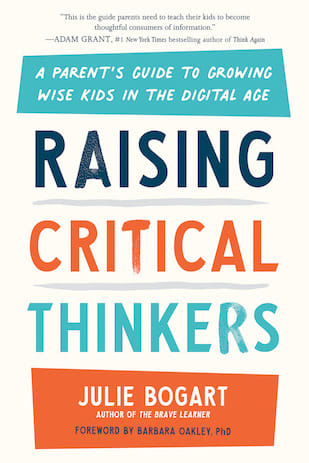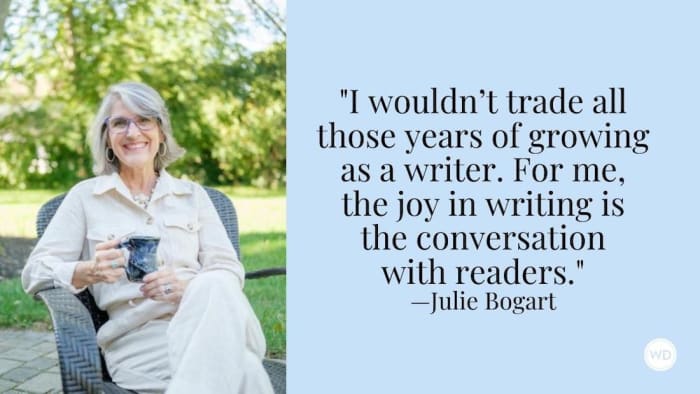Julie Bogart: On Navigating the Digital World
Julie Bogart is known for her commonsense parenting and education advice. She’s the author of the beloved book, The Brave Learner, which has brought joy and freedom to countless home educators. Her new book, Raising Critical Thinkers, offers parents a lifeline in navigating the complex digital world our kids are confronting.
Julie’s also the creator of the award-winning, innovative online writing program called Brave Writer, now 22 years old, serving 191 countries. She home educated her five children who are globe-trotting adults. Today, Julie lives in Cincinnati, Ohio, and can be found sipping a cup of tea while planning her next visit to one of her lifelong-learning kids. Find her on Twitter, Facebook, and Instagram.
In this post, Julie discusses the 20 years of observations and research that led to her new nonfiction book, Raising Critical Thinkers, the joy in conversations with readers, and more!
Name: Julie Bogart
Literary agent: Rita Rosenkranz
Book title: Raising Critical Thinkers
Publisher: TarcherPerigee
Release date: February 1, 2022
Genre/category: Nonfiction
Previous titles: The Brave Learner
Elevator pitch for the book: Raising Critical Thinkers teaches parents how to help their children be thoughtful consumers of information—whether in school, online, or interpersonally.
IndieBound | Bookshop | Amazon
[WD uses affiliate links.]
What prompted you to write this book?
The internet! I was in my 30s at the time the world wide web came online. It took me by surprise that people who would never speak in hurtful ways to one another in person were so willing to sling insults and misinformation at each other online. I got to thinking about our children who have never known a world without that kind of engagement, and wanted to create for parents a pathway to help them help their kids be discerning readers and skilled thinkers.
How long did it take to go from idea to publication? And did the idea change during the process?
I have been working on various aspects of this book for 20 years. But once I had the contract, it took about 18 months of dedicated research and three to four months of drafting the book itself.
The main idea didn’t change, but the structure of the book really did. At first, I thought I’d write a collection of chapters, each as a standalone piece about an aspect of thinking. But as I got into crafting the book, it became a book with an internal narrative—it should be read chronologically as the ideas build to a kind of climax in part three.
Were there any surprises or learning moments in the publishing process for this title?
Yes. I wanted the title to be Raising Self-Aware Thinkers. My editor felt that the title was too vague from a marketing point of view. She suggested “critical thinkers” instead. At first, I was concerned that I would have to reorient the book. But instead, the new title gave me an additional aspect of research to consider with more depth. In the end, the title has served me so well and I think I’ve contributed a whole new way to think about what critical thinking is.
Were there any surprises in the writing process for this book?
My biggest “aha!” moment came when I did research into how having the internet on our phones is literally rewiring how our brains think. I went in expecting to find that this was not true. Instead, what I learned is that we are being conditioned away from deep-focus attention states, which are essential to critical thinking.
Nichola Carr’s book The Shallows was quite persuasive. It led me down a rabbit trail of more research which expanded the concepts and helped me create a far more nuanced argument for how to use the internet in our families.
What do you hope readers will get out of your book?
I hope that they feel equipped both to think well themselves, and to guide their children into a life of discernment.
If you could share one piece of advice with other writers, what would it be?
I learned early that if you want to write, you need readers. I have written thousands upon thousands of words over the decades that have been offered freely online. I’ve listened to my readers. I’ve worked to get readers. What I know today is that readers are interested in your work when you offer them an insightful (new-to-them) take, that also simultaneously validates their lived experience.
It’s a toggling between being familiar enough to be credible and novel enough to grab their attention. To me, I wouldn’t trade all those years of growing as a writer. For me, the joy in writing is the conversation with readers.

Throughout this 12-week course, you will get step-by-step instruction on how to write nonfiction, read Philip Gerard’s Creative Nonfiction: Researching and Crafting Stories of Real Life, and write articles, essays, or a few chapters of your book. Register for this course and discover how fun writing nonfiction can be.




